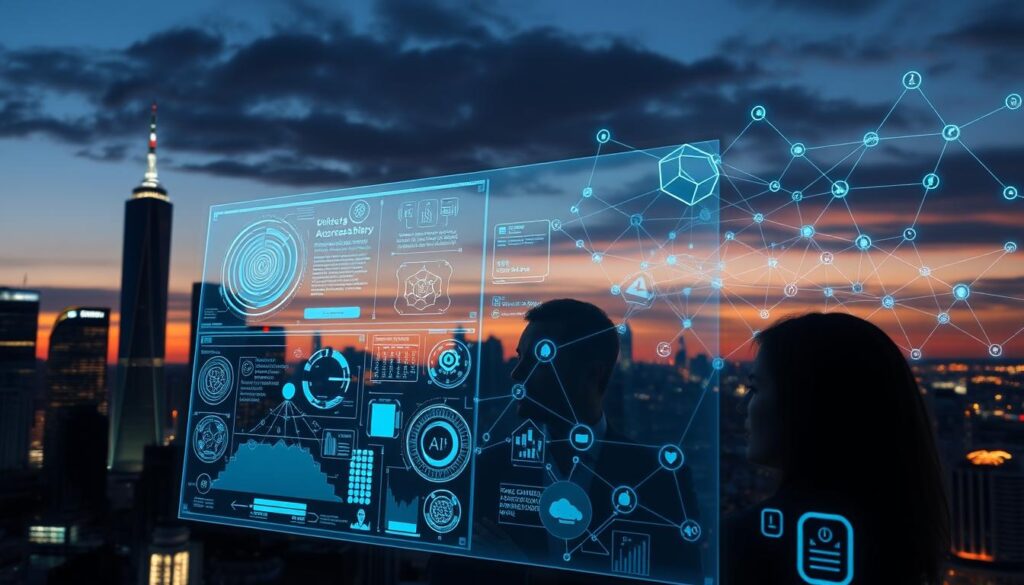As Albert Einstein once said, “The measure of intelligence is the ability to change.” In today’s digital landscape, this rings especially true. The rise of advanced technologies has introduced new challenges, but also innovative solutions. Digital guardians are now at the forefront, transforming how we approach defense strategies.
These systems continuously learn and adapt, ensuring they stay ahead of emerging risks. By analyzing vast amounts of data in real time, they enhance threat detection and response capabilities. This shift from reactive to proactive defense is reshaping the way organizations safeguard their assets1.
For instance, traditional methods often require manual updates, which can be time-consuming and error-prone. In contrast, these digital solutions automate processes, reducing response times significantly1. This efficiency is crucial in countering increasingly complex risks, such as those posed by autonomous malware1.
Key Takeaways
- Digital guardians continuously evolve to counter emerging risks.
- Real-time data analysis enhances threat detection capabilities.
- Automation reduces response times and minimizes human error.
- Proactive defense strategies are replacing reactive approaches.
- Advanced solutions are essential to combat sophisticated threats.
Understanding the Evolution of Cybersecurity

From simple antivirus software to advanced systems, the journey of digital protection has been remarkable. In the early days, the focus was on basic measures to combat viruses and malware. These methods were effective for their time but lacked the sophistication needed to handle today’s complex risks2.
As technology advanced, so did the threats. This led to the development of more robust solutions. Modern systems now integrate advanced technologies to address these challenges. They are designed to analyze data in real time, enhancing detection capabilities and improving overall security3.
Historical Context and Current Trends
The first wave of digital safety focused on rule-based systems. These were effective but limited in scope. The second wave introduced machine learning, allowing for more dynamic solutions. Today, the third wave emphasizes intelligent systems capable of contextual understanding and adaptability2.
Current trends highlight the importance of proactive measures. Organizations are now integrating comprehensive detection systems to identify threats before they escalate. This shift is crucial in managing the increasing volume of risks3.
From Reactive to Proactive Defense
Traditional methods often relied on reactive approaches. These required manual updates and were prone to errors. In contrast, modern systems automate processes, reducing response times significantly2.
Proactive strategies focus on anticipating risks and taking preventive actions. This approach not only enhances security but also minimizes potential damage. By leveraging advanced technologies, organizations can stay ahead of emerging threats3.
For more insights on how these strategies are shaping the future, explore key predictions for 2025.
How AI Agents Revolutionize Threat Detection

The digital age demands smarter solutions to stay ahead of evolving risks. Advanced systems now employ adaptive learning to refine their capabilities continuously. By analyzing vast amounts of data, these systems detect anomalies in real time, ensuring faster responses to potential threats4.
Adaptive Learning and Real-Time Decision-Making
Adaptive learning allows systems to evolve by processing new information. This approach reduces false positives and enhances accuracy in identifying risks4. Real-time decision-making further accelerates responses, outpacing traditional manual interventions5.
For example, these systems can flag unusual patterns in network traffic, enabling immediate action4. This capability is crucial for organizations aiming to minimize damage from cyberattacks6.
Leveraging Predictive Analytics for Cyber Defense
Predictive analytics plays a vital role in anticipating threats before they occur. By analyzing historical data and identifying trends, these systems can forecast potential risks5. This proactive approach strengthens overall defense mechanisms.
Organizations like Aston Martin have successfully adopted these technologies to protect sensitive data4. Such advancements highlight the importance of integrating predictive tools into modern security strategies.
For more insights on how these strategies are shaping the future, explore AI in business.
AI Agents in Cybersecurity: Protecting Against Modern Threats

In today’s fast-paced digital environment, staying ahead of risks requires innovative approaches. Advanced systems have emerged as a powerful tool to combat cyber threats, offering both proactive and reactive capabilities. These systems analyze vast amounts of data in real time, ensuring faster detection and response to potential risks7.
One of the key roles of these systems is their ability to act as a comprehensive solution. By automating routine tasks, they free up resources for more complex issues, optimizing overall security strategies8. For example, organizations like Accenture have successfully integrated these technologies to enhance their resilience against cyber threats7.
These systems also transform strategies by offering proactive threat management. Predictive analytics, powered by advanced technologies, allow organizations to anticipate risks before they escalate9. This approach not only minimizes damage but also strengthens overall defense mechanisms.
Adopting these technologies is no longer optional but essential. The global market for such solutions is expected to reach $38.2 billion by 2026, reflecting their growing importance8. Organizations that leverage these tools are better equipped to navigate the complex landscape of cyber threats, ensuring robust protection of their digital assets7.
In conclusion, advanced systems are redefining how organizations approach security. By acting as both a tool and a solution, they provide a multi-layered defense against evolving risks. Embracing these technologies is crucial for staying ahead in the ever-changing digital world.
Exploring Various Types of AI Agents

The digital landscape is evolving rapidly, demanding innovative solutions to address emerging challenges. Advanced systems are now playing a critical role in safeguarding digital assets. These tools come in various forms, each designed to tackle specific aspects of security.
Intrusion Detection Systems and Automated Response
Intrusion detection systems monitor network behavior in real time, identifying unusual patterns that could indicate a threat. These systems leverage advanced technology to analyze vast amounts of data, ensuring immediate detection of potential risks10.
When a threat is detected, automated response protocols engage instantly. This ability to act within seconds significantly reduces the time it takes to neutralize risks, compared to traditional methods that may take hours or days10.
Proactive Threat Hunting Tools
Proactive tools go beyond detection, actively searching for vulnerabilities before they can be exploited. These systems use predictive analytics to anticipate risks, enhancing overall security strategies11.
By expanding access controls and reducing vulnerability, these tools provide a multi-layered defense. Organizations can now stay ahead of threats, ensuring robust protection of their digital assets10.
These diverse systems highlight the importance of integrating advanced technology into modern security frameworks. By doing so, organizations can enhance their ability to respond to and mitigate risks effectively.
Key Capabilities and Benefits of AI-Driven Defense

The rapid evolution of digital threats has made advanced defense systems essential for organizations. These systems leverage cutting-edge technologies to provide robust protection, ensuring businesses stay ahead of emerging risks. By integrating advanced analytics and real-time monitoring, they transform how organizations approach their strategy for safeguarding digital assets.
Enhanced Data Analysis and Pattern Recognition
One of the standout features of these systems is their ability to analyze vast amounts of data in real time. By identifying patterns that may indicate a threat, they enhance detection accuracy and speed12. Traditional tools often miss anomalies, but advanced systems improve detection rates significantly, reducing exposure to risk12.
Predictive analytics further strengthens these capabilities. By analyzing historical data, these systems can forecast potential threats, enabling proactive measures13. This approach minimizes damage and ensures organizations are always one step ahead.
24/7 Operation for Uninterrupted Security
Continuous monitoring is another critical advantage. These systems operate non-stop, providing real-time insights into potential threats13. This ensures uninterrupted protection, even outside business hours.
Automated response mechanisms further enhance efficiency. When a threat is detected, the system can act within seconds, reducing containment times from weeks to minutes12. This speed is crucial in minimizing the impact of attacks.
By adopting these technologies, organizations can build a comprehensive strategy that combines proactive and reactive measures. This not only strengthens their defense but also ensures long-term resilience against evolving threats14.
Customized Defense Strategies for Organizations

Organizations today face unique challenges that demand tailored solutions for effective protection. One-size-fits-all approaches often fall short in addressing specific vulnerabilities. Advanced systems now offer the capability to design strategies that align with individual needs, ensuring robust defense mechanisms15.
Tailoring Security Protocols to Unique Needs
Every organization has distinct operational requirements and risk profiles. Advanced systems analyze these factors to create customized protocols. For example, they can assess network behavior and identify potential entry points for attackers15. This tailored approach ensures that security measures are both effective and efficient.
By leveraging predictive analytics, these systems can anticipate risks specific to an organization’s environment. This proactive strategy minimizes exposure to threats and enhances overall resilience16.
Cost and Resource Efficiency Improvements
Customized strategies not only improve protection but also optimize resource allocation. Advanced systems automate routine tasks, reducing the need for manual intervention. This leads to significant cost savings and allows teams to focus on more complex issues17.
For instance, automated systems can detect and respond to threats within seconds, compared to traditional methods that may take days15. This efficiency is crucial for organizations aiming to maximize their capability while minimizing expenses.
The evolving role of security teams is another key benefit. By working alongside advanced systems, teams can focus on strategic planning and decision-making. This collaboration enhances overall effectiveness and ensures long-term protection16.
For more insights on how these strategies are shaping the future, explore key trends in digital finance.
The Future of AI in Cybersecurity

The future of digital defense is being reshaped by groundbreaking technologies. These innovations are transforming how organizations anticipate and respond to emerging risks. By leveraging vast amounts of datum, advanced systems enhance decision-making and streamline the process of threat detection18.
Innovative Technologies and Emerging Trends
One of the most significant advancements is the use of generative models to simulate attack scenarios. These systems analyze patterns in network behavior, flagging deviations that may indicate a breach18. This type of technology not only improves detection but also strengthens overall resilience.
Automation is another key trend, reducing the need for manual intervention. By automating routine tasks, organizations can focus on more complex challenges, optimizing their process of defense19.
Anticipating and Preparing for New Risks
Predictive analytics plays a crucial role in anticipating future threats. By analyzing historical datum, these systems can forecast potential risks, enabling proactive measures18. This approach minimizes damage and ensures organizations stay ahead of evolving challenges.
Integration of new types of systems into existing frameworks is also essential. These tools provide a multi-layered defense, enhancing the overall process of safeguarding digital assets19.
As the landscape evolves, organizations must prepare for more sophisticated risks. By adopting these technologies, they can build a robust defense strategy, ensuring long-term protection18.
Overcoming Implementation Challenges

Implementing advanced technologies in security systems comes with its own set of challenges. Organizations must navigate ethical concerns, privacy issues, and technical hurdles to ensure seamless integration. These barriers can disrupt established network patterns and delay the adoption of effective solutions20.
Addressing Ethical and Privacy Concerns
One of the most pressing challenges is ensuring ethical use and protecting user privacy. Advanced systems often require access to sensitive data, raising concerns about misuse or breaches. For example, a global financial institution reduced potential incidents by 67% but had to address privacy concerns during implementation20.
Organizations must establish clear guidelines to balance innovation with ethical responsibility. This includes transparent data handling practices and robust safeguards to prevent unauthorized access21.
Integrating with Legacy Systems
Another significant hurdle is integrating modern tools with older, legacy systems. These outdated frameworks often lack compatibility with advanced detection systems, creating gaps in security20. For instance, traditional methods may fail to identify zero-day vulnerabilities, leaving systems exposed to attacks21.
To overcome this, organizations can adopt phased integration strategies. By gradually updating infrastructure, they minimize disruptions and ensure compatibility with newer technologies22.
Real-world examples show that addressing these challenges is possible. Companies like Accenture have successfully integrated advanced systems while maintaining ethical standards and compatibility with legacy frameworks20.
Integrating AI Agents with Existing Cybersecurity Infrastructure

Organizations are increasingly turning to advanced technologies to enhance their security frameworks. This shift is driven by the need to stay ahead of evolving risks while maintaining operational efficiency. However, integrating these tools into existing systems presents unique challenges that require careful planning and execution23.
Strategies for Seamless Technology Adoption
One of the primary challenges is ensuring that new tools do not disrupt current protocols. A phased approach can help organizations integrate advanced systems gradually, minimizing downtime and compatibility issues24. For example, 82% of IT leaders plan to enhance their security frameworks with advanced technologies within the next two years23.
Another strategy involves leveraging automation to streamline processes. Automated tools can handle routine tasks, freeing up teams to focus on more complex issues. This not only improves efficiency but also reduces the risk of human error23.
Managing Vast Amounts of Data Effectively
Advanced systems generate and process enormous volumes of data, which can be overwhelming without proper management. Real-time data analysis is crucial for identifying anomalies and potential threats quickly23. By 2025, the projected data overflow is expected to reach 79 zettabytes, highlighting the need for robust data management strategies23.
Predictive analytics can further enhance this process by forecasting potential risks based on historical data. This proactive approach allows organizations to address vulnerabilities before they escalate24.
As organizations prepare for the future, integrating advanced technologies into their security frameworks is essential. By adopting these strategies, they can overcome challenges and build a resilient defense system that adapts to evolving threats23.
Regulatory and Ethical Considerations

The integration of advanced technologies into security systems has raised significant regulatory and ethical questions. As these systems handle a vast amount datum, ensuring compliance with laws and maintaining ethical standards becomes critical25.
Bias, Accountability, and Transparency
One of the primary concerns is bias in decision-making. Systems that process large datasets may inadvertently reinforce existing biases, leading to unfair outcomes26. This issue is particularly problematic in sensitive areas like law enforcement and healthcare.
Accountability is another key factor. When automated systems make errors, determining responsibility can be challenging. For example, erroneous flagging of legitimate activities as threats can cause significant disruptions25.
Transparency is essential to build trust. Organizations must ensure that their processes are clear and understandable. This includes explaining how decisions are made and what data is used27.
Managing Malware and Erroneous Flagging
Advanced systems are designed to detect and neutralize malware effectively. However, they are not immune to errors. False positives can lead to unnecessary actions, while false negatives can leave systems vulnerable25.
To address this, strict guidelines are necessary. These guidelines should ensure that systems are regularly tested and updated to minimize errors26. For more insights on managing these challenges, explore AI agents and cybersecurity.
Building Trust and Fairness
Maintaining trust in automated systems is crucial. Users need to feel confident that these systems are fair and reliable. This requires ongoing monitoring and adjustments to ensure they meet ethical standards27.
Fairness can be achieved by implementing diverse datasets and regular audits. These measures help identify and correct biases, ensuring that systems operate equitably25.
Recommendations for Ethical Practices
Organizations should adopt comprehensive training programs to educate employees on ethical considerations. This includes understanding the potential risks and how to mitigate them26.
Additionally, collaboration with regulatory bodies can help establish best practices. By working together, organizations can ensure that their systems are both effective and ethical27.
The Rise of Agentic AI in Modern Cyber Defense
The digital landscape is witnessing a transformative shift with the emergence of autonomous systems in defense strategies. These systems operate independently, leveraging advanced technologies to detect and respond to threats in real time. Their ability to process vast amount datum and analyze patterns ensures faster and more accurate responses28.
Autonomous Threat Detection and Incident Response
Autonomous systems excel in identifying abnormal behavior by analyzing network activity. They can detect anomalies that may indicate a potential threat, enabling immediate action29. This capability significantly reduces the time it takes to neutralize risks, outperforming traditional methods by orders of magnitude28.
One of the key advantages is their ability to handle multiple alerts simultaneously. Unlike human analysts, these systems do not experience fatigue, ensuring consistent and thorough investigations28. This efficiency is crucial in addressing the increasing scale of digital threats.
By leveraging machine intelligence, these systems can correlate information across different environments. This contextual awareness allows them to dismiss benign alerts efficiently, focusing only on genuine risks28. Such precision enhances overall defense mechanisms.
Case examples highlight their success in neutralizing sophisticated attacks. For instance, a financial institution reduced incident response times by 67% after integrating autonomous systems29. These real-world applications demonstrate their transformative impact on digital defense strategies.
As organizations continue to adopt these technologies, their ability to process and analyze large amount datum will remain a cornerstone of modern defense. This shift towards autonomy ensures robust protection against evolving risks28.
Preparing for the Future: Skills and Strategic Investment
The evolving digital landscape demands a proactive approach to staying ahead of emerging risks. Organizations must focus on upskilling their teams and investing in next-generation solutions to build a resilient defense system. This dual strategy ensures they can handle the increasing complexity of digital threats effectively.
Upskilling Cybersecurity Teams
Continuous training and development are crucial for cybersecurity professionals. With 92% of organizations experiencing breaches last year, the need for skilled teams is more pressing than ever30. Upskilling enhances collaborative efforts between humans and advanced systems, improving overall efficiency.
Organizations should focus on equipping their teams with the latest knowledge and tools. This includes understanding emerging threats and leveraging advanced technologies for better activity monitoring. By doing so, they can reduce response times and minimize potential damage30.
Investing in Next-Generation Solutions
Strategic investments in innovative technologies are essential for future-proofing defense mechanisms. More than 60% of organizations believe advanced solutions will strengthen their future cybersecurity efforts30. These investments should focus on real-time data analysis and predictive analytics to anticipate risks before they escalate.
For example, integrating next-generation tools can help organizations manage a vast amount of data efficiently. This ensures they can identify anomalies quickly and respond to threats in real time31. Such proactive measures are critical in today’s fast-paced digital environment.
To stay ahead, organizations must prepare for the future cybersecurity landscape by adopting these technologies. For more insights, explore how cybersecurity threats in 2025 are shaping the industry.
Conclusion
The role of advanced technologies in reshaping defense strategies cannot be overstated. These systems excel at their ability to analyze vast amounts of data, enabling proactive threat detection and swift responses32. This capability ensures organizations stay ahead of emerging risks, minimizing potential damage.
Ethical implementation remains a cornerstone of effective defense. Balancing innovation with responsibility ensures trust and fairness in automated systems33. Organizations must prioritize transparency and accountability to maintain robust security frameworks.
Looking ahead, strategic investments in artificial intelligence will continue to drive innovation. By focusing on upskilling teams and adopting next-generation tools, organizations can build resilient defenses34. The future of digital protection lies in leveraging these technologies to anticipate and neutralize threats effectively.
FAQ
How do AI-driven tools enhance threat detection?
What role does adaptive learning play in cybersecurity?
Can AI-powered solutions operate continuously?
How do AI tools handle vast amounts of data?
What are the benefits of proactive threat hunting?
How can AI improve cost efficiency in cybersecurity?
What challenges arise when integrating AI with legacy systems?
What ethical concerns are associated with AI in cybersecurity?
How can organizations prepare for future cybersecurity threats?
What is the role of predictive analytics in cyber defense?
Source Links
- An Introduction Agentic AI in Cybersecurity
- Council Post: The Evolution Of AI Agents In The Third Wave Of AI
- AI In Cybersecurity: Enhancing Protection Against Modern Threats
- AI Threat Detection: Leverage AI to Detect Security Threats
- How SOC AI Agents Are Revolutionizing Cybersecurity in 2025
- How AI Agents Are Reinventing Cybersecurity | Verdentra
- AI Agents: The Future of Cybersecurity Defense & Threat Intelligence 🔒🤖
- AI Agents in Cybersecurity 2025 | Ultimate Guide
- The Role of AI in Cybersecurity
- SmythOS – AI Agents in Cybersecurity: Proactive Threat Detection and Response
- The Role of Artificial Intelligence (AI) in Cyber Security
- Artificial Intelligence in Cybersecurity
- Role Of Artificial Intelligence (AI) In Modern Cybersecurity
- AI-Driven Threat Hunting: Proactive Cyber Defense
- AI in Cyber Security: Top 6 Use Cases – TechMagic
- Accenture’s AI Agent Security: Enhancing Cyber Resilience
- How AI Is Transforming Cyber Threat Detection – Dataminr
- What Is Generative AI in Cybersecurity?
- Innovation, Automation, And The Cybersecurity Challenges Ahead
- The Rise of AI-Driven Cybersecurity: Protecting Your Business Against Emerging Threats
- Enhancing Cyber Security through Artificial Intelligence and Machine Learning: A Literature Review
- Enhancing Cybersecurity through AI and ML Strategies, Challenges, and Future Directions
- AI in cybersecurity: Use cases, implementation, solution and development
- Cybersecurity and AI: Threats and opportunities
- Attacking Artificial Intelligence: AI’s Security Vulnerability and What Policymakers Can Do About It
- Cybersecurity Snapshot: 6 Best Practices for Implementing AI Securely and Ethically
- How agentic AI handles the speed and volume of modern threats – Help Net Security
- Agentic AI: The Future of Automation and Associated Risks – HUMAN Security
- The force awakens: What Gen AI means for the future of cybersecurity
- 2023 DOD Cyber Strategy Summary
- How “Automated Intervention” (AI) is Changing Modern-Day Cybersecurity
- Leveraging Generative AI and AI Agents for Supplier Risk and Cybersecurity
- Security of AI Agents







